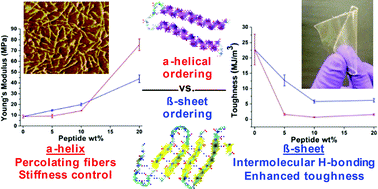Influence of secondary structure and hydrogen-bonding arrangement on the mechanical properties of peptidic-polyurea hybrids†
Abstract
Bio-inspired materials design is an important strategy used in the fabrication of tunable and mechanically enhanced polymeric systems. An important aspect of bio-inspiration is to understand how components, such as hierarchy and self-assembly, affect the properties of the designed materials. In this investigation, we explore the use of polypeptide secondary structure and hydrogen bonding arrangement, in order to determine their effects on the thermal and mechanical properties of fully synthetic peptidic polyureas. Specifically, we incorporate either short β-sheet forming peptide blocks of poly(β-benzyl-L-aspartate)5 or poly(ε-carbobenzyloxy-L-lysine)5 or longer peptide blocks of poly(β-benzyl-L-aspartate)20 or poly(ε-carbobenzyloxy-L-lysine)20 as α-helix forming domains into non-chain extended polyureas based on 1,6-hexamethylene diisocyanate and poly(dimethysiloxane). Secondary structure was found to be influenced by the weight fraction of peptide, e.g. increasing peptide weight fractions increased sheet or helical ordering. Additionally, the polyurea microstructure was comprised of nanofibrils with a secondary structure dependent fiber width, attributed to the peptidic motif alignment within the nanothreads. Analysis of the thermomechanical and tensile response revealed multiple trends, such as increased toughness attributed to β-sheet ordering and increased modulus with increased peptide weight fraction. It is anticipated that this observed interplay between peptide organization and mechanics will be applicable to engineering and biomaterial development due to the simplicity of the synthetic protocol and the promising mechanical tunability guided by the peptide segment.

- This article is part of the themed collection: Emerging Investigators

 Please wait while we load your content...
Please wait while we load your content...